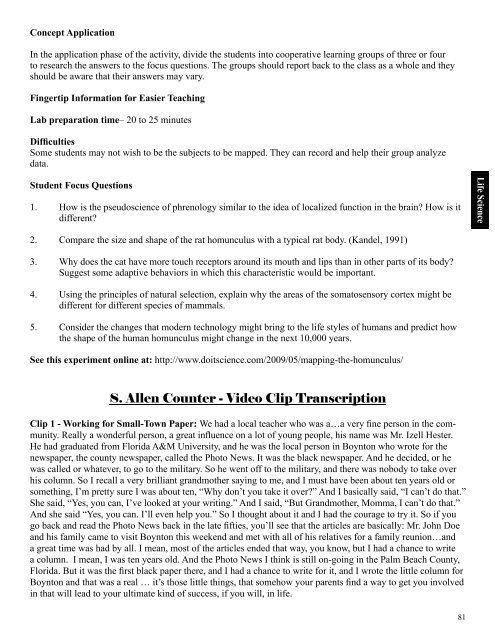ScienceMakers Toolkit Manual - The History Makers
ScienceMakers Toolkit Manual - The History Makers
ScienceMakers Toolkit Manual - The History Makers
Create successful ePaper yourself
Turn your PDF publications into a flip-book with our unique Google optimized e-Paper software.
Concept Application<br />
In the application phase of the activity, divide the students into cooperative learning groups of three or four<br />
to research the answers to the focus questions. <strong>The</strong> groups should report back to the class as a whole and they<br />
should be aware that their answers may vary.<br />
Fingertip Information for Easier Teaching<br />
Lab preparation time– 20 to 25 minutes<br />
Diffi culties<br />
Some students may not wish to be the subjects to be mapped. <strong>The</strong>y can record and help their group analyze<br />
data.<br />
Student Focus Questions<br />
1. How is the pseudoscience of phrenology similar to the idea of localized function in the brain? How is it<br />
different?<br />
2. Compare the size and shape of the rat homunculus with a typical rat body. (Kandel, 1991)<br />
3. Why does the cat have more touch receptors around its mouth and lips than in other parts of its body?<br />
Suggest some adaptive behaviors in which this characteristic would be important.<br />
4. Using the principles of natural selection, explain why the areas of the somatosensory cortex might be<br />
different for different species of mammals.<br />
5. Consider the changes that modern technology might bring to the life styles of humans and predict how<br />
the shape of the human homunculus might change in the next 10,000 years.<br />
See this experiment online at: http://www.doitscience.com/2009/05/mapping-the-homunculus/<br />
S. Allen Counter - Video Clip Transcription<br />
Clip 1 - Working for Small-Town Paper: We had a local teacher who was a…a very fi ne person in the community.<br />
Really a wonderful person, a great infl uence on a lot of young people, his name was Mr. Izell Hester.<br />
He had graduated from Florida A&M University, and he was the local person in Boynton who wrote for the<br />
newspaper, the county newspaper, called the Photo News. It was the black newspaper. And he decided, or he<br />
was called or whatever, to go to the military. So he went off to the military, and there was nobody to take over<br />
his column. So I recall a very brilliant grandmother saying to me, and I must have been about ten years old or<br />
something, I’m pretty sure I was about ten, “Why don’t you take it over?” And I basically said, “I can’t do that.”<br />
She said, “Yes, you can, I’ve looked at your writing.” And I said, “But Grandmother, Momma, I can’t do that.”<br />
And she said “Yes, you can. I’ll even help you.” So I thought about it and I had the courage to try it. So if you<br />
go back and read the Photo News back in the late fi fties, you’ll see that the articles are basically: Mr. John Doe<br />
and his family came to visit Boynton this weekend and met with all of his relatives for a family reunion…and<br />
a great time was had by all. I mean, most of the articles ended that way, you know, but I had a chance to write<br />
a column. I mean, I was ten years old. And the Photo News I think is still on-going in the Palm Beach County,<br />
Florida. But it was the fi rst black paper there, and I had a chance to write for it, and I wrote the little column for<br />
Boynton and that was a real … it’s those little things, that somehow your parents fi nd a way to get you involved<br />
in that will lead to your ultimate kind of success, if you will, in life.<br />
81<br />
Life Science










